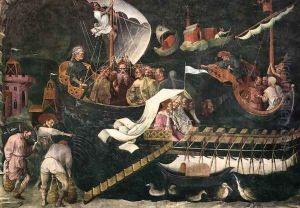Giovanni Da Modena Paintings
Giovanni da Modena, also known as Giovanni di Pietro Falloppi or Giovanni Baronzio, was an Italian painter who was active during the late 14th and early 15th centuries, a period that marked the transition from Medieval to Renaissance art. He was born around 1379 in Modena, Italy, and he is primarily known for his work in the region of Emilia-Romagna. Not much is known about his early life or training, but he is believed to have been influenced by the works of other Italian artists such as Vitale da Bologna.
Giovanni's style combined Gothic and early Renaissance elements. His works are noted for their vivid color palette, attention to detail, and the narrative quality of his frescoes. One of Giovanni's most famous works is a series of frescoes in the Basilica of San Petronio in Bologna, which he painted around 1410. This includes the large fresco of the Last Judgment, which is particularly notable for its depiction of a scene from Dante's 'Inferno', showing the Prophet Muhammad in Hell, a subject matter that has generated controversy in recent times.
Throughout his career, Giovanni da Modena worked on many ecclesiastical commissions, creating altarpieces, frescoes, and other religious artworks. His style exhibits the typical International Gothic characteristics of graceful figures and a strong narrative element, yet there are also signs of the new Renaissance style emerging, particularly in his use of perspective and volume in the depiction of figures.
Giovanni's contributions to Italian art are significant in that they represent the stylistic shifts occurring at the time. Despite not being as widely recognized as some of his contemporaries, his work provides a valuable insight into the artistic developments of his era. It is believed that Giovanni continued to work until the 1450s, and he likely died in or around 1455. His legacy is preserved in the surviving works that continue to be studied and admired for their blend of medieval tradition and Renaissance innovation.
